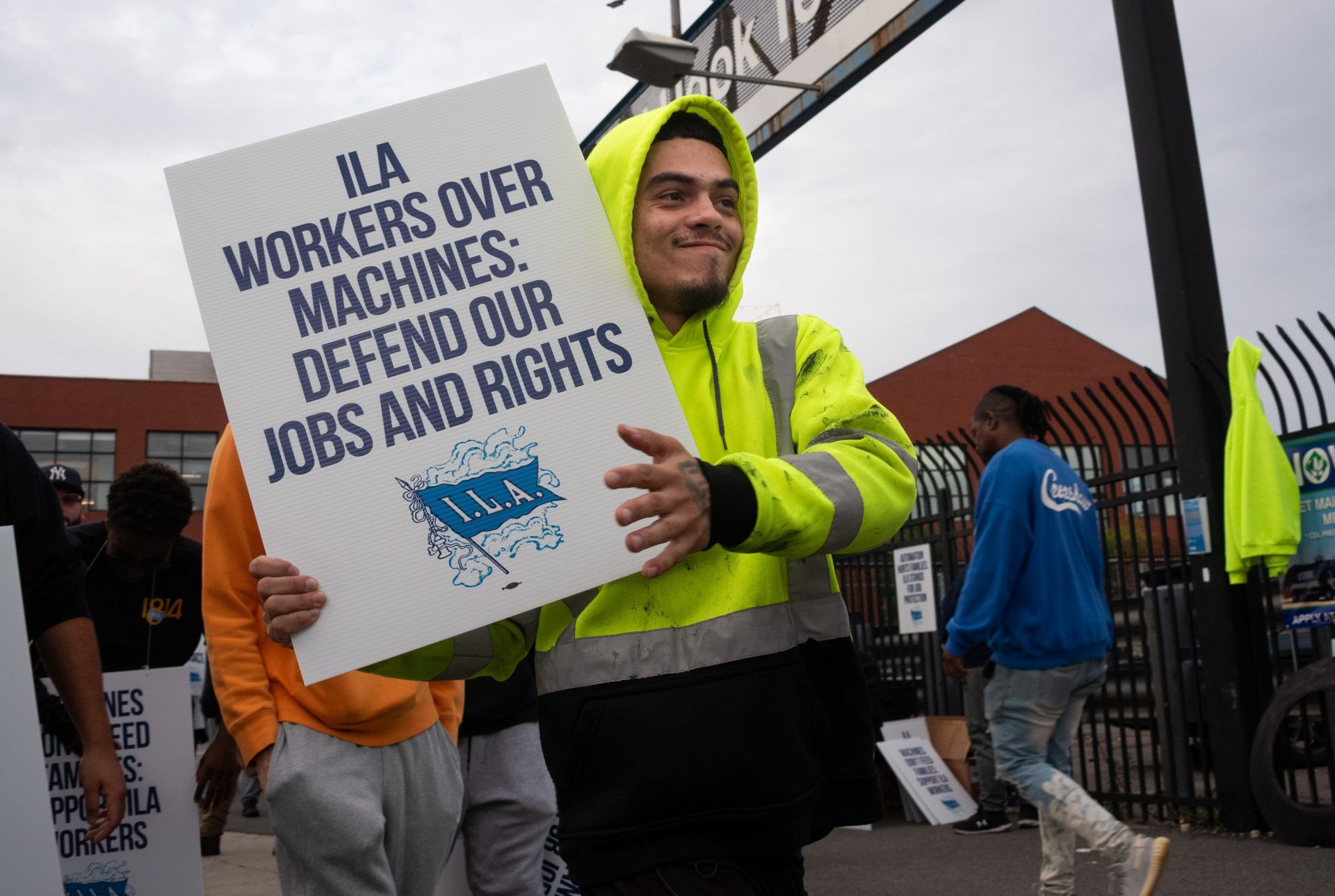By Don Lee
Los Angeles Times
(TNS)
The union representing thousands of dockworkers from Maine to Texas launched a strike Tuesday over wages and the use of automation, shutting down seaports with a work stoppage that threatens to cause significant disruption to trade and the national economy.
It was the first strike since 1977 for the International Longshoremen’s Assn., whose 47,000 members handle cargo operations at three dozen ports on the East and Gulf coasts that receive about half of U.S. imports. And it comes at a delicate time, economically and politically, as the country is emerging from a period of high inflation and is just a month away from national elections.
President Biden, who has championed the cause of labor during his time in the White House, has said he would not break up the strike. On Tuesday he stood squarely on the side of the union, issuing a statement urging the United States Maritime Alliance, the group representing mostly foreign shipping lines and other employers at the ports, “to come to the table and present a fair offer to the workers.”
“Ocean carriers have made record profits since the pandemic and in some cases profits grew in excess of 800% compared to their profits prior to the pandemic,” the president said, noting that executives and shareholders have been enriched. “It’s only fair that workers, who put themselves at risk during the pandemic to keep ports open, see a meaningful increase in their wages as well.”
The maritime alliance had no immediate comment on Biden’s statement but said late Monday that it had offered a wage increase of nearly 50% over six years. The union has been pressing for wage increases of 77%, and its leader, Harold Daggett, doubled down on the demand as he spoke on the picket lines at the Port of New York and New Jersey. Top-scale longshore workers earn a base pay of $39 an hour.
Republican lawmakers and business groups, including the National Assn. of Manufacturers, urged Biden to apply the 1947 Taft-Hartley Act to end the strike. President George W. Bush used that authority in 2002 to halt an 11-day lockout of union members at West Coast ports.
If the strike ends quickly, it isn’t expected to have big consequences for businesses or consumers. Many retailers had their products shipped earlier than usual and built up inventory in anticipation of a labor action. Many imported toys and holiday accessories such as Christmas ornaments, for example, arrived in late summer instead of October, as they would during more normal times, analysts said.
Some importers have transported goods by air and others have rerouted cargo to the West Coast, adding to traffic at the ports of Los Angeles and Long Beach, the busiest container complex in the U.S.
But each passing day of a strike it will cost billions of dollars in lost trade, economists say, although some of that would be recouped later. And if the ports remain shut down for longer than a week or two, more significant and wider effects will hit the economy, including snarled supply chains and increased logistics costs, as happened during the pandemic.
For consumers, the effects initially may be relatively minor and even unnoticeable, with products such as European wine and perishables such as bananas costing more, said Jason Miller, a supply chain management expert at Michigan State University. But after a couple of weeks, he said, automakers that produce cars in the U.S. could be forced to slow production or even impose temporary layoffs if they can’t get enough imported parts and components. Through July, 56% of car parts and 71% of motor vehicles that are imported came through the East and Gulf coasts, according to Miller’s analysis of Census Bureau data.
“There’s just a limit to what the system can take. You can only divert so much,” he said.
Thanks in part to diverted cargo, the ports of Los Angeles and Long Beach combined had their busiest August ever this year. Both ports have geared up for increased volume in anticipation of the strike.
“Folks have been preparing for this day for months,” said Gene Seroka, executive director of the Port of Los Angeles. Through August, he said, the port’s volume is up 17% from last year’s level. “We just ended the third quarter and it’ll be our best on record.”
West Coast dockworkers are represented by a different union, the International Longshore & Warehouse Union, or ILWU, which agreed to a new contract with the Pacific Maritime Assn. last year.
A union spokesperson said Tuesday that the ILWU had no public comment on the strike at this time. William Adams, the ILWU’s president, previously sent a letter to Daggett pledging solidarity with the East Coast union, and in a symbolic gesture of support, he joined the picket lines Tuesday on the East Coast.
Dockworkers on the West Coast could not, though, easily refuse to unload products diverted from the East in a show of solidarity, because cargo destinations are booked before vessels set sail, making it hard to know what and where they might otherwise have gone. California port operations could be affected if the striking longshore workers union in the East set up pickets here, as it did in San Francisco during the strike in 1977. But even then, the ILWU’s actions may be constrained by contract rules.
An ILWU spokesperson said he had not heard of any plans for the eastern union to come to West Coast ports.
The ports of Los Angeles and Long Beach report that they have capacity to handle more cargo rerouted from the East, although additional volume could create some bottlenecks.
“Port operators on the West Coast learned to operate under severe duress during the reopening of trade following pandemic-era distortions,” said Joseph Brusuelas, chief economist at the tax and consulting firm RSM US. “We think that this will partially mitigate some of those that will adversely impact trade volumes during the duration of the labor action.”
Brusuelas estimated the strike would affect about $1.3 billion in exports and $3 billion in imports daily, still a modest figure given the size of the American economy. “The major industries impacted by this action will be local transportation and warehousing and imports of autos,” he said. “Agricultural goods, coal, and petroleum figure to see the greatest short-term impact.”
The effects will be heaviest in places that are home to or support the biggest ports along the Atlantic and Gulf coasts, including New York- New Jersey; Savannah, Ga.; Houston; and Charleston, S.C. The Port of New York and New Jersey, the busiest on the East Coast, said 100,000 containers were waiting to be unloaded, with 35 ships expected to arrive this week. The Port of L.A.’s Seroka said that even a short strike closing a port for just a week might cause a backlog that could take four to six weeks to clear.
A lengthy strike could lead to broader price increases and create some shortages during the holiday shopping season. Businesses in California say they expect the strike will also touch them, though perhaps not as hard, with consumers ultimately bearing the cost.
“If we have learned anything at all from previous supply chain disruptions, it is that the fallout results in higher cost for consumers on goods like clothing, fruits and vegetables and medical supplies,” said Patty Tschaepe, president of the Los Angeles Customs Brokers and Freight Forwarders Assn.
International Longshoremen’s Assn. members started picketing after their six-year labor contract with the United States Maritime Alliance expired at midnight.
The union has pushed hard against employers wanting to use robotics and other labor-saving technologies. The alliance said Monday that it had offered to maintain the current language on automation and semi-automation.
________
©2024 Los Angeles Times. Visit latimes.com. Distributed by Tribune Content Agency LLC.
Thanks for reading CPA Practice Advisor!
Subscribe Already registered? Log In
Need more information? Read the FAQs
Tags: Payroll, Small Business




